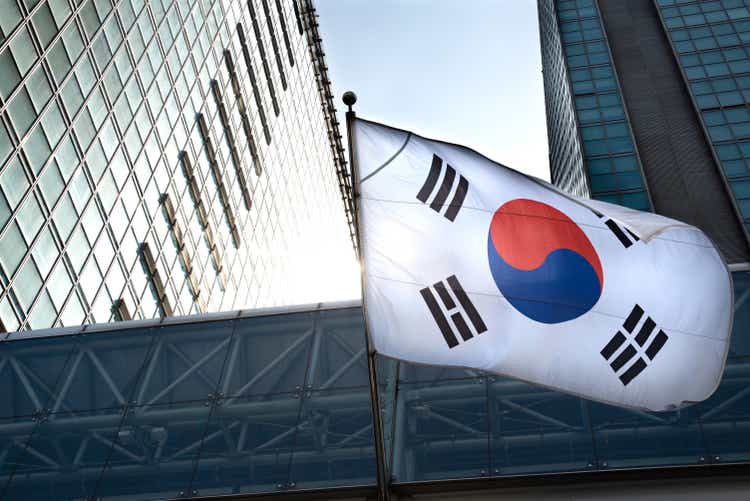[ad_1]
Jae Young Ju
Elevator Pitch
I continue to rate Korea Electric Power Corporation’s (NYSE:KEP) [015760:KS] shares as a Buy. In my previous write-up for KEP published on October 11, 2022, I reviewed Korea Electric Power’s Q2 2022 financial results and highlighted the stock’s depressed valuations.
With the current article, I focus on recent news flow which suggests that things can only get better for Korea Electric Power going forward. KEP’s shares performed well in the past two months thanks to positive developments relating to the government and the company. I think there is still lots of room for Korea Electric Power’s share price to rise further, taking into account expectations of an improvement in KEP’s financial performance for 2023. Therefore, I decide to maintain a Buy rating for Korea Electric Power.
Strong Share Price Rebound
Korea Electric Power’s shares rose by +49% from its 52-week low of $5.76 recorded during intra-day trading on October 24, 2022 to close at $8.57 at the end of the December 23, 2022 trading day.
KEP’s excellent stock price performance in the last two months indicate that the worst might be over for Korea Electric Power, as investor sentiment towards the company turns positive. In the subsequent sections of this write-up, I touch on a couple of developments which have changed how the market perceives the future of Korea Electric Power.
Electricity Tariff Increase
Changes to electricity tariffs in South Korea have a significant impact on the future revenue and bottom line of Korea Electric Power. As such, it isn’t a surprise that KEP’s share price reacted positively to developments which increase the probability of electricity tariff hikes.
On December 9, 2022, The Korea Times reported that “lawmakers voted down a revision bill of the Korea Electric Power Corporation Act” which prevented KEP from lifting its “upper limit in corporate bond issuance.” In response to this piece of news, KEP’s share price went up by +8% from $7.41 as of December 8, 2022 to $8.02 as of December 9, 2022. Korea Electric Power’s shares did well on December 9, 2022, because investors saw the recent news as a positive sign of the Korean government being supportive of tariff hikes as the preferred way (as opposed to issuing more debt) of supporting KEP’s future business operations.
Given that Korea Electric Power didn’t get the necessary approvals to raise fresh funds from new debt issuance, it becomes increasingly important that electricity tariff hikes are initiated to keep KEP afloat despite inflationary cost pressures. In other words, the rejection of Korea Electric Power’s application to secure additional debt financing makes it more likely that the Korean government will allow for an increase in South Korea’s electricity tariffs in the foreseeable future.
Purchased Power Cost Savings
Purchased power expenses for Korea Electric Power doubled from KRW15 trillion in the first nine months of 2021 to KRW30 trillion for 9M 2022, according to the company’s latest November 2022 investor presentation slides. It is also noteworthy that purchased power was KEP’s largest cost item in absolute terms in this year thus far.
Therefore, if Korea Electric Power can reduce its purchased power costs, this will boost the company’s future profitability in a very meaningful way.
Based on a December 5, 2022 Korea JoongAng Daily news article, the Korean government will impose a “cap on wholesale electricity prices” for power purchased by KEP for a three-month period. This implies that Korea Electric Power will be able to realize purchased power cost savings for the final month of 2022 and the first two months of 2023.
Divestments And Capex Cuts
KEP isn’t just pinning all its hopes on the South Korean government; the company is also doing its best to optimize its asset portfolio and business operations.
One key thing to note is that Korea Electric Power has plans to restructure the company’s portfolio of assets and monetize some of its non-core assets. Specifically, KEP intends to sell its non-renewables projects that are located outside of its home market, South Korea.
Another key item to pay attention is that KEP’s actual capital expenditures for 2023 might be way lower than what the company incurred in 2022. According to a December 7, 2022 Reuters article citing interviews with sell-side analysts, the market is anticipating a 20% cut in capital expenditures for Korea Electric Power in the following year.
In a nutshell, Korea Electric Power still has levers to improve its near-term financial performance with moves such as capex reduction and divestitures.
Financial Outlook
An analysis of the sell-side analysts’ consensus financial forecasts for Korea Electric Power leads me to the conclusion that 2022 was most probably the bottom for KEP in terms of financial performance.
As per S&P Capital IQ’s consensus data, KEP’s revenue growth is projected to accelerate from +9.1% in fiscal 2022 to +24.3% for FY 2023. This is likely attributable to tariff rate hikes and a recovery in power demand for the Korean market.
Separately, analysts predict that Korea Electric Power’s normalized net loss per share will more than halve from -KRW37,633 for FY 2022 to -KRW18,542 in FY 2023. Over the same time period, the sell-side sees KEP’s negative free cash flow narrowing from -KRW24.9 trillion to -KRW12.4 trillion. As discussed earlier in this article, Korea Electric Power should benefit from a reduction in both purchased power costs and capital expenditures in the near term.
Concluding Thoughts
Korea Electric Power’s shares continue to warrant a Buy rating in my opinion. KEP’s prospects are good judging by recent news flow, and I expect the company to maintain its positive share price momentum considering its 2023 financial outlook.
[ad_2]
Image and article originally from seekingalpha.com. Read the original article here.

